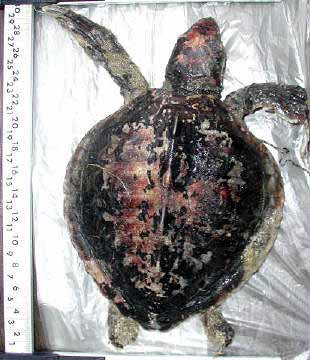Expecting the Unexpected — 18 January 2002 The temperature topped out today at 36 degrees with the wind blowing off the water at 15 knots. The forecast calls for 10 inches of snow starting Saturday afternoon. Slush formed two weeks ago along the bayside coast, putting an end to any hope of recovering live sea turtles. The last few tossed shore, including 45 pound loggerheads, were frozen like ice cubes. So, with these conditions in mind, what would be the last thing a turtle researcher would expect on the 18th of January? Read on, McDuff. To catch everyone up on turtle developments out here at the northern edge of the universe, Wednesday witnessed the last sea turtle wash-ashore of the 2001 stranding season. It was the tiniest Kemp’s ridley of the year, measuring only 19.4 centimeters long and weighing 942 grams, considerably smaller than a mature diamondback terrapin. She reached us DOA. In fact, the last live turtle — a loggerhead — was rescued on December 29th. Total for the season: 96 sea turtles (88 Kemp’s ridleys, 6 loggerheads and 2 green turtles). The year 2001 represented the third largest stranding season on record. The highest was 1999 with 277 sea turtles, followed by 1995 with 178. Last year was the fourth largest with 48. So, clearly, the number of cold-stunned sea turtles recovered on Cape Cod beaches has escalated over the last decade. We mustn’t forget Bubbles, the injured diamondback terrapin recovering in my garage lab from substantial wounds received on 16 October (see Holiday Guests — 13 December 2001). | |||||||

![]()
 When found on the beach, Bubbles (a.k.a. #1195) weighed 1283 grams. Fasting since then while undergoing medical treatment, she had dropped nearly 15% of her body weight when she reached Connemara Cottage a month ago. After a little over a week of orientation to her new surroundings, she began eating again and now, with a voracious appetite, she has regained a substantial percentage of her loss. She’s scheduled for another checkup at the end of January to see if her smashed bridge has begun to heal. Right now I’m a bit concerned about her vigorous appetite. I’m wondering if the artificial fasting from mid-October to mid-December, followed by immersion in a warm (~ 75-degree) tank with ample food supply, hasn’t tricked her internal clock. Yep — I’m worried she may be eating for twelve or maybe sixteen. I’ll check her for gravidity the next time her tank water is changed. And, no, while that would be fairly surprising and a serendipitous experiment in sperm storage, it’s not the “unexpected” event of which I write. Over the last week we’ve had a series of storms pass over the Cape, some with winds over 50 mph and others with driving rain. After a set of weather events such as these, I patrol the coastline. Erosion brings egg shells to the surface and exposes nest chambers, allowing us to discover new nesting locations. And, as you may recall from last spring (see Luck All Around —11 May 2001), some Wellfleet hatchlings overwinter in their nests, only to emerge the next spring. Storms may dredge them to the surface prematurely and, in these conditions, they will succumb almost immediately to the elements. So, yesterday I walked the length of the Great Island peninsula looking for nesting signs without luck. Yet, today young Miss Emily Sperbeck with her mom and grandmom walked the same path and discovered — a diamondback terrapin hatchling! Obviously, forced out of its nest, Hatchling 001-02 was found lying on its back at the base of the Great Island parking lot path. It was presumed dead as the Sperbecks rushed the hatchling to the Sanctuary, but heated by Emily’s hands en route, the turtle began to kick and push her way to freedom. |
  |
Almost exactly an inch long, she weighed only 4 grams and seemed quite dehydrated. She was also deformed with her right side and plastron squished as though she had been wound tightly by roots inside the nest chamber (see Miracle on Round Island — 17 May 2001) . |